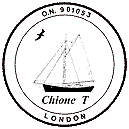
|
|
|
|
|
|
|
|
|
|
Batteries and Charging
Choose the 'Equipment' button to return to the Equipment Index.
Why a section on batteries?
Well partly because I spent 15 years of my life working for a battery manufacturer and so a decent battery installation was a MUST when specifying the boat. There are many advantages to Nickel Cadmium batteries on a boat: long life, greater operating temperature range, little voltage drop-off with increasing discharge, and the ability to use a greater proportion of their rated capacity. They are however VERY expensive, even when you work for the manufacturer.Technically we have two quite different electrical requirements on our boats: a very high current for a very short period is needed for engine starting, whilst a modest discharge current is required for as long as possible to power our domestic services. Ideally we would use different types for the two functions. But, what happens when one fails? A true deep-discharge type will not be able to provide the cranking amps needed to start your engine, whilst a small engine starter won't provide the discahrge capacity to keep the lights (and the instruments, and the fridge) going for too long. Having decided on the type of batteries to use, how about keeping them properly charged, and how do you know just what state of charge they are in?
This section explains the solution we finally decided upon, with some of the justification for our choices.
| Sowester "Super Marine" ( 80Ah + 130Ah) |
|
||
| Chione T | London | O/N 901053 | R.T. 6 54/100 |
| Poweramp 'Merlin' 12/15-2 |
|
||
| No battery will
regain its maximum capacity unless you use a proper charging
regime. Essentially, we would like to charge them quickly,
charge them to their fullest potential, and then float them at "full"
for long life.
Note on sizing the charger: This charger drops down to float voltage at 25% of the maximun charging current (i.e. at 3.75A). Ideally, this should occur when then charging current drops down to 2-3% of battery capacity. There are several useful papers on marine electrical system design in the West Marine Advisor. |
|||
| Chione T | London | O/N 901053 | R.T. 6 54/100 |
| Sterling Advanced Alternator Regulator |
|
||
| The voltage
regulator on your engine's
alternator is designed to recharge an engine starting battery.
Normally,
engine start batteries only become marginally discharged and a crude
charging
regime will make very little difference. [If you have a blocking diode
to
split the alternator's charge between two batteries you'll also have
the
problem that the regulator is sensing the voltage at the engine not at
the
batteries. The blocking diode is likely to drop the voltage by
around
1 volt.]
For these reasons an external
regulator
is desirable. The Sterling version has: |
|||
| Chione T | London | O/N 901053 | R.T. 6 54/100 |
| Link 10 |
|
||
No matter how well you arrange the charging regime, how do you know: This compact meter provides
answers
to these, and more, questions on its digital readout. A simple
set
of LEDs also provides a continuous visual indication of remaining
capacity. |
|||
| Chione T | London | O/N 901053 | R.T. 6 54/100 |
